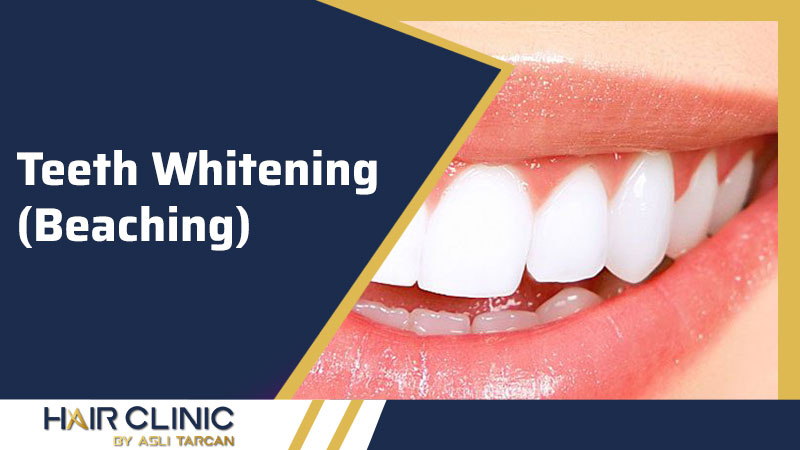Teeth Whitening (Bleaching) Professional teeth whitening at the dentist is a quick way to make a whiter smile, but is it the best whitening method for you? Teeth whitening (or bleaching) is a simple, non-invasive dental treatment used to change the color of natural tooth enamel and is an ideal way to enhance the beauty of your smile.
While some people appreciate the safety benefits of a whitening treatment provided by a trained professional, others find the prices to be prohibitively high.
Because white teeth have now become the number one cosmetic concern of most patients, there are several ways to whiten teeth. The most popular method is to use a home teeth whitening system that will whiten your teeth. Since teeth whitening only works on natural tooth enamel, it is important to evaluate the replacement of any old fillings, crowns, etc.
Teeth whitening is not permanent. It may need to be renewed every few years and more often if you smoke, drink coffee, tea, or wine.
Is professional whitening worth the cost?
In this article, we will explain various professional teeth whitening options and the pros and cons of each. Find out how much teeth whitening costs at the dentist and how long it takes to see results. And if you decide that it is too expensive to whiten your teeth professionally, we also have some suggestions for alternative methods.
We hope this information will help you decide on the best teeth whitening treatment for your needs.
Reasons for teeth whitening (bleaching):
- Fluoridation (excessive fluoridation during tooth development).
- Normal wear of the outer layer of the teeth.
- Painted teeth due to drugs (tetracycline, etc.).
- Yellow, brown stained teeth.
What does teeth whitening involve?
This type of teeth whitening usually requires two visits. During the first appointment, impressions (molds) will be created by your teeth to make plastic, clean discs.
On your second appointment, you will test the discs for a proper fit and make adjustments if necessary. The trays are worn with a special bleaching solution twice a day for 30 minutes or overnight for a few weeks depending on the degree of staining and the desired level of bleaching. It is normal to feel tooth sensitivity when whitening your teeth, but it will subside shortly after you stop whitening.
You will receive care instructions for your teeth and discs and you will be encouraged to visit your dentist regularly to maintain a beautiful, healthy, white smile.
Professional teeth whitening options
There are many popular methods used by dentists for teeth whitening. But before we take a closer look, let’s take a quick look at how teeth whitening (bleaching) works so you can understand what happens when you whiten your teeth with a dentist.
How do teeth whiten?
Whatever treatment you choose, the teeth whitening process involves the application of bleach (often hydrogen peroxide) to remove stains and the appearance of white on the teeth.
Qualified dental staff are allowed to use higher concentrations of peroxide than those found in over-the-counter teeth whitening kits, which means that professional whitening can offer better results.
Bleaching of external teeth
Most cosmetic teeth whitening works by applying whitening agent to the outside of the tooth. The hard outer layer of the enamel is naturally transparent and is the yellow dentin beneath which gives the teeth their yellowish color. The whitening product absorbs the enamel to lighten the dentin, which in turn makes the teeth look brighter.
Dentists use lasers, LED lights or other products applied to the teeth to speed up the whitening and speed up the teeth whitening (bleaching) process. Although these methods can produce almost immediate results, there is little evidence that they make teeth whiter in the long run than a professional durable whitening kit.
Bleaching of internal teeth
It is also possible to apply bleach inside the tooth. This method is used to whiten an individual tooth that has discolored, for example as a result of root canal work.
This procedure involves making a small hole in the tooth and inserting the whitening agent into the affected area. The hole is closed with a temporary filling and the bleach is left for a while before being removed. This process can be repeated until the tooth becomes lighter.
Facing a white spot
White spot reversal treatment is a minimally invasive, cost-effective procedure provided by trained dental hygienists to reverse white matter damage to teeth, with long-term results. This procedure preserves the enamel and can prevent the need for more extensive treatment.
Dental Hygiene
White spots can appear during tooth formation or due to poor oral hygiene. They look like white scars or milky white spots anywhere on the tooth, but especially on the gum line and around the tips of orthodontic brackets.
Your hygienist will see you once a week for a series of 5-7 visits. Each visit lasts about 30 minutes. The phosphoric acid gel will be applied to the affected areas for about 30 seconds. This will open the pores of the enamel. The area will be rinsed, dried and polished with pumice. A topical cream with concentrated calcium and phosphates is polished in the area.
These metals are driven deep into the white spot for repair, restoration and restoration of transparency and color uniformity. Custom discs should be worn twice a day, for 5 minutes a day for topical cream treatment, between appointments. No needles needed, no drilling or filling required.
In this article we focus on external cosmetic whitening techniques that illuminate all teeth at the same time. If you have a single discolored tooth, talk to your dentist about internal whitening options.
Benefits of visiting a dentist for whitening
Although the cost of teeth whitening (bleaching) at the dentist is higher than alternatives at home, there are some safety benefits from treating a professional:
- The dentist will check that you are a good candidate for whitening. If you have gingivitis or caries, for example, bleaching is not recommended.
- For office whitening, your gums will be protected with a seal or shield.
- Mouthwashes are specially designed to fit your teeth well and ensure even gel coverage
- The dentist controls the intensity and duration of your treatment to produce the results you want.
- There is also a higher level of patient satisfaction for whitening in a dental clinic. A 2018 report found that 69% of patients were “happy” or “very happy” with their results – compared to just 42% of those who had used whitening kits at home. Dissatisfaction with teeth whitening at home is generally due to lack of results or tooth sensitivity.
Why get a whitening treatment in the office?
Most home whitening kits do surface work, reducing surface stains. It may take up to a month to see results and your teeth will get maybe three or four shades lighter. Disks at home that you can get at the dentist are more effective, but you will have to wait a week or two to get results.
With laser teeth whitening, the process takes more than an hour and you have long-term results. It uses light-activated whitening and just one appointment can make your teeth eight shades lighter. You will not get this kind of immediate effect from a whitening kit at home.
Please note that only registered dental professionals are allowed to whiten teeth. It is illegal for places like beauty salons to whiten teeth (or even to provide professional endurance whiteners) unless there is a dentist. Only dentists have the right training to know what to do if something goes wrong during your treatment.
How long does teeth whitening (bleaching) take?
As you will see below, the best professional teeth whitening methods can show results with just one hour of treatment in the dentist’s office. You may need several visits to the dentist to achieve the desired results, so the total time for teeth whitening can be a few weeks.
If you choose a professional whitening kit, you should start to see results after a few days of daily use, but the treatment will continue for about 10-14 days.
Laser teeth whitening
This form of whitening, also known as “laser whitening” or “power whitening”, uses a laser to accelerate the whitening effect of a concentrated gel applied to the teeth.
Laser teeth whitening costs more than other methods, but it is also the closest you will get to “instant” teeth whitening. If fast results are your main concern, this could be the best professional teeth whitening method for you.
The first step in the laser teeth whitening process is to apply a seal or shield to protect the gums. The teeth are then coated with a whitening product – usually containing hydrogen peroxide. A laser that shines on the teeth during the treatment makes this whitening technique so fast and effective.
The results of laser whitening should be clear after a visit, but your dentist may suggest that you repeat the procedure to achieve the results you want.
Because laser bleaching is such an intensive method, there is a greater chance of sensitivity after treatment. This should be removed fairly quickly, but can be uncomfortable for some patients and extremely painful for others.
Teeth whitening (LED)
An alternative whitening procedure performed in dental surgery is zoom whitening. Using technology from Phillips, this works in a similar way to laser bleaching, but instead uses LEDs to speed up the bleaching agent.
LED teeth whitening systems like Zoom are not as intense as laser treatment, so you may need more than one session to see the results you want, although Phillips claims it can whiten teeth up to 8 shades in a timely manner.
With the Zoom chair whitening, each session lasts 45 minutes to an hour, with the light applied for two or three 15-minute periods. This can be followed by a course of teeth whitening treatment at home to prolong the results.
LED bleaching has largely replaced ultraviolet bleaching, as it is safer and more effective. It is the ultraviolet light that causes sunburn and skin cancer, so its use in the mouth can damage the gums, cheeks and lips.
How much teeth whitening at the dentist?
As you can see from the table above, professional teeth whitening (bleaching) at the dentist costs from $ 150 to $ 1,500 – depending on the procedure you choose.
Laser teeth whitening costs more due to the technology used, but offers the most effective results quickly. Teeth whitening at home costs less because you spend relatively little time in the dentist’s chair.
Note that the main advantage of laser and LED bleaching on transfer trays is the speed with which they produce results. If you are happy with more gradual whitening, a home whitening kit will still give good results during the treatment.
It is worth receiving offers from more than one dentist, as the professional cost of teeth whitening varies from one clinic to another depending on various factors.
Professional teeth whitening (bleaching) costs and options: Conclusion
If you want fast results, laser whitening and LED whitening can whiten teeth with many shades in just one hour. A whitening kit provided by your dentist is a more affordable way to achieve good results while still being under the supervision of a dentist.
Laser Whitening
All of these methods of professional teeth whitening at the dentist cost hundreds – or even thousands – of pounds, so people who want a cheaper way to get white teeth can try a teeth whitening kit at home. There are many brands of kits available, and if you make this choice, it is important to use a kit that complies with strict quality regulations.
Our complete teeth whitening guide has more information about kits and other teeth whitening methods (including some natural techniques), as well as how to take care of your whitened teeth and make your results last longer. If you want to have a teeth whitening (bleaching) treatment to have a healthy smile, we are waiting for you to our clinic.



